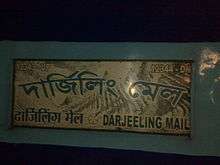Darjeeling Mail
 | |||||
| Overview | |||||
|---|---|---|---|---|---|
| Service type | Superfast Mail | ||||
| First service | 1 January 1879 | ||||
| Current operator(s) | Eastern Railway of Indian Railways | ||||
| Ridership | most Popular train | ||||
| Route | |||||
| Start | Sealdah railway station (SDAH) | ||||
| Stops | 4 | ||||
| End | New Jalpaiguri Junction (NJP) | ||||
| Distance travelled | 567 km (Sealdah-New Jalpaiguri)[1] | ||||
| Service frequency | Daily | ||||
| Train number(s) | 12343/12344 | ||||
| On-board services | |||||
| Class(es) | AC 1st (1), AC 2nd (2), AC 3rd (7), Sleeper (9), General (6) | ||||
| Catering facilities | No Pantry Car available - one must buy food at the starting station | ||||
| Technical | |||||
| Rolling stock | Siliguri shed WDP4/WDP4B /WDP4D locomotive | ||||
| Track gauge | 1,676 mm (5 ft 6 in) | ||||
| Operating speed | Average speed-65kph. Maximum speed 110kph. Generally runs at 80-105kph | ||||
| |||||
| Darjeeling Mail route | |
|---|---|
|
Notes: |
The Darjeeling Mail is one of the legendary trains in the eastern region of India that has been running from pre-independence days and is still in operation. It connects to the Darjeeling Himalayan Railway at New Jalpaiguri in Siliguri. This is a major train for Kolkata-Siliguri route and Haldibari slip route.
History
Run via East Bengal
During the British period all connections to North Bengal were through East Bengal.
From 1878, the railway route from Kolkata, then called Calcutta, to Siliguri was in two laps. The first lap was a 185 km journey along the Eastern Bengal State Railway from Calcutta Station (later renamed Sealdah) to Damookdeah Ghat on the southern bank of the Padma River. The passengers would then avail a ferry across the river. The second lap of the journey was a 336 km metre gauge line of the North Bengal Railway that linked Saraghat on the northern bank of the Padma to Siliguri.[2]
Later the 1.8 km long Hardinge Bridge across the Padma came up in 1912.[3] In 1926 the metre-gauge section north of the bridge was converted to broad gauge, and so the entire Calcutta - Siliguri route became broad-gauge.[2] The route thus roughly ran: Sealdah-Ranaghat-Bheramara-Hardinge Bridge-Iswardi-Santahar-Hili-Parabtipur-Nilphamari-Haldibari-Jalpaiguri-Siliguri.
The Darjeeling Mail ran on this route in pre-partition days. Even after the partition of India it ran on this route for some years.[4][5]
Ferry across Ganges(Post-partition)
With the partition of India in 1947, the major hurdle in connecting Kolkata and Siliguri was that there was no bridge across the Ganges in West Bengal or Bihar. A generally acceptable route to Siliguri was via Sahibganj Loop to Sakrigali ghat, then across the Ganges by ferry to Manihari Ghat on the other side,then to Kishanganj via Katihar and Barsoi and finally through narrow gauge to Siliguri.[6] In 1949 Kishanganj-Siliguri section was too converted to metre gauge,thus making the entire route an uni-gauge one.[2]
Run via Farakka Barrage
In the early 1960s, when Farakka Barrage was being constructed, a more radical change was made. Indian Railways created a new broad-gauge rail link from Kolkata, and on a greenfield site south of Siliguri Town built an entirely new broad-gauge junction, New Jalpaiguri.[2]
The 2,240 metres (7,350 ft) long Farakka Barrage carries a rail-cum-road bridge across the Ganges. The rail bridge was thrown open to the public in 1971, thereby linking the Barharwa-Azimganj-Katwa Loop Line to Malda Town, New Jalpaiguri and other railway stations in North Bengal.[7][8] Since then Darjeeling Mail has been using the Howrah-New Jalpaiguri line.
According to latest report, there is a plan to run the darjeeling mail in a new route. The new route is Sealdah - DumDum - Barrackpore - Murshidabad - Azim gang - Malda - NJP. This is done to minimise increased & heavy traffic at Bardhaman & Bolpur railway station. Moreover the old route faces too much congestion and is little bit lengthy which results in delay. Besides the people of Murshidabad was deprived from all train running from sealdah/howrah to North-Bengal. The new route & new trains on this route will ensure them better journey. There is a plan to start the new route within December 2017. The new track is completed & ready and is under clearance. The Eastern railway has already sent a proposal for the change of the route of darjeeling mail to the Railway Board as soon the new route gets its clearance.
Route and halts
The important halts of the train are:
Operation
12343 - Starts from Sealdah Daily at 22:05 Hrs IST and reach New Jalpaiguri Junction next day at 8:00 Hrs IST
12344 - Starts form New Jalpaiguri Junction at 17:45 Hrs IST and reach Sealdah at 6:00 Hrs IST
Gallery
 Darjeeling Mail - AC 3 tier
Darjeeling Mail - AC 3 tier Darjeeling Mail - Sleeper Class
Darjeeling Mail - Sleeper Class
References
- ↑ "Darjeeling Mail 12343". Clear Trip. Retrieved 2012-03-04.
- 1 2 3 4 "India: the complex history of the junctions at Siliguri and New Jalpaiguri". IRFCA. Retrieved 2011-11-12.
- ↑ Chowdhury, Sifatul Quader (2012). "Hardinge Bridge". In Islam, Sirajul; Jamal, Ahmed A. Banglapedia: National Encyclopedia of Bangladesh (Second ed.). Asiatic Society of Bangladesh.
- ↑ Joydeep Dutta and Harsh Vardhan. "Trains of Fame and Locos with a Name, part 2". IRFCA. Retrieved 2012-02-22.
- ↑ "Geography - International". IRFCA. Retrieved 2012-02-22.
- ↑ "my school i wish". Madhyamgram Re-visited after 15 years. Retrieved 2011-01-23.
- ↑ Salman, Salman M. A.; Uprety, Kishor (2002). Conflict and cooperation on South Asia's international rivers: a legal perspective. World Bank Publications. pp. 135–136. ISBN 978-0-8213-5352-3. Retrieved 2011-07-05.
- ↑ R.P.Saxena. "Indian Railway History timeline". Retrieved 2011-11-20.
External links
|
| |
|
|
_route_map.png)